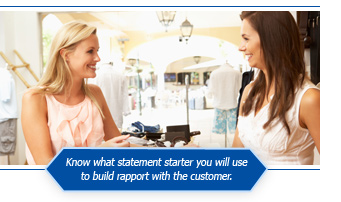About Your Business
Ignite Selling Productivity by Using a Creative-Problem-Solving Selling Method:
Building Rapport and Defining the Customer’s Needs
by Dan Coleman
One of the most effective ways for sales professionals to ignite selling productivity is to use a Creative-Problem-Solving Selling Method. In using a Creative-Problem-Solving Selling Method, the sales professional looks at interests and needs through the lens of the customer, and not through a self-serving lens. In the first issue of The PartnerShip Connection we went over the four steps to using a Creative-Problem-Solving Selling Method. Here we will discuss the first two steps more in-depth.
Step 1: Open the Discussion and Build Rapport
Greet and welcome customers. Put them at ease and build rapport by being friendly, and by finding common ground and a common topic. An opening general phrase to break the ice could be, “You came at a really good time; it was very busy a little while ago.” Know what statement starter you will specifically use to build rapport and jumpstart the conversation.

Step 2: Discover and Define the Customer Interests and Needs
Here you put yourself in the customer’s shoes and relate to their concerns, interests, and needs. Do this by asking, in a non-threatening way, pertinent, open-ended questions that begin with who, what, where, when, why, and how. This approach will help you to explore and understand what the customer wants to solve, accomplish, or avoid. An opening discovery question could be, “What brings you into the store today?” Once you’ve asked your open-ended question, give the customer space to talk freely and provide more than a short answer – and listen to what they say. As you listen to the customer, it’s important to understand the difference between a customer:
- Not being aware of a need
- Having an implied need (small problem, difficulty, and/or dissatisfaction)
- Having an explicit need (strong wants & desires)

Upon identifying primary needs, ask close-ended questions to focus attention on a specific thought, statement, or action and elicit a yes or no answer, a specific fact answer, or quantification. For example, “Would you like the shirt in blue or green?” If the customer has multiple needs, asking an evaluating question assists the customer in prioritizing their needs. To illustrate: If you had 100 points to distribute across all of your needs, how would you allocate them?
After you have discovered and defined the customer interests and needs, transition to Step 3: Generate Ideas to Address the Customer Interests and Needs – and Recommend a Solution. Look for next month’s edition of The PartnerShip Connection where we will discuss the finals steps in developing and using a Creative-Problem-Solving Selling Method.
Dan Coleman, the founder and president of Excelsior Learning, has a B.S. from State University of New York and is currently working on a M.A. in Creative Studies at Buffalo State College. He is consistently praised by his clients as a highly knowledgeable and energizing trainer who brings fresh content, practical tools, and unique experiential learning methods to deliver training that works. For more information visit www.excelsior-learning.com. Contact Dan by email at dancoleman@excelsior-learning.com or by phone at 330-284-5446.
How Using a 3rd Party Freight Partner Can Help Your Business
In the multifaceted world of transportation and logistics, the business of moving freight can be a confusing and costly venture. Which carrier is the best for your desired shipping route? Which carrier is the most cost-effective, and offers the customer service level that you need? Are you getting a competitive rate? Many companies turn to a third-party freight provider to help navigate the maze of carriers, rates, routes, and freight classifications ... MORE
What’s in a freight rate?
Have you ever heard “I can offer you a 90% discount off of carrier base rates for all of your shipments” or “I can save you 30% to 40% off of what you paid for freight last year?”
Here are a few tips to give you insight into what’s really in a freight rate ...
MORE
What’s in a freight rate?
Q: What are the benefits of receiving a volume quote if my shipment is more than 5,000lbs.?
A. Many times, volume quotes will give you a spot price that is better than your normal discounted rate. These spot prices will depend on how much volume a carrier has going in your particular lane on that day. These larger shipments are very desirable to most carriers, because they take up a lot of space in the trailer but require a lot less handling.
Q: When looking at a freight quote from a carrier or freight partner, how do I know if the liftgate charge is included?
A. Accessorial charges should be listed separately on a quote as an additional charge. If it’s not broken out or listed they probably didn’t include the charge.
What’s in a freight rate?
PartnerShip routinely saves us hundreds of dollars on individual freight shipments. This ends up being a huge annual cost saving especially considering freight is one of our bookstore’s biggest expenses. I’ve found PartnerShip to be easy to use and the level of service we get from our rep is unparalleled. We were walked through the PartnerShip website and now our receiving manager can easily price out freight vendors, set up shipments, and track those shipments in one easy place. PartnerShip is what its name implies: a true partner to the college store.
Abbie Shellist
UT Bookstore
What’s in a freight rate?
Have you ever heard “I can offer you a 90% discount off of carrier base rates for all of your shipments” or “I can save you 30% to 40% off of what you paid for freight last year?”
Here are a few tips to give you insight into what’s really in a freight rate...MORE